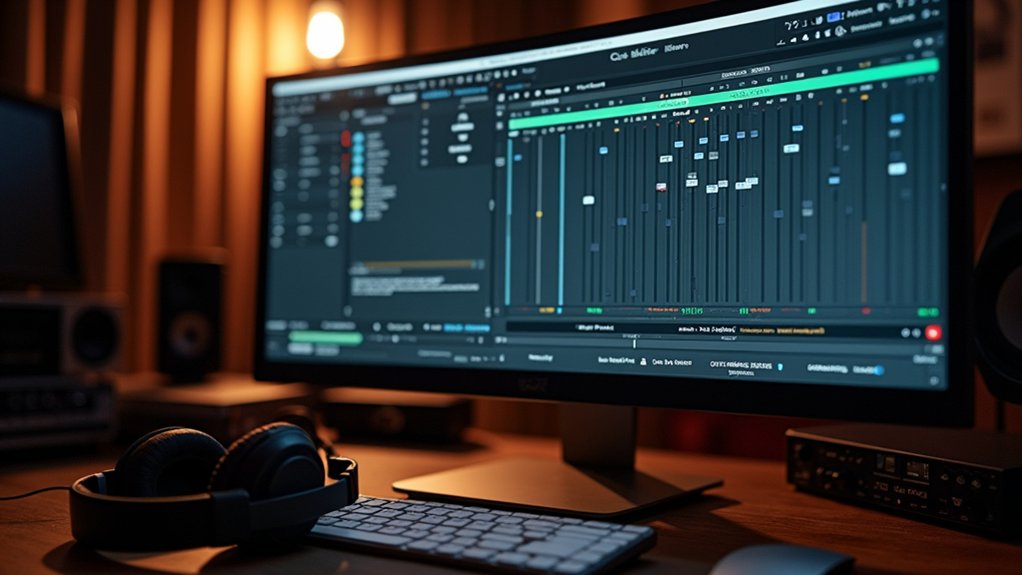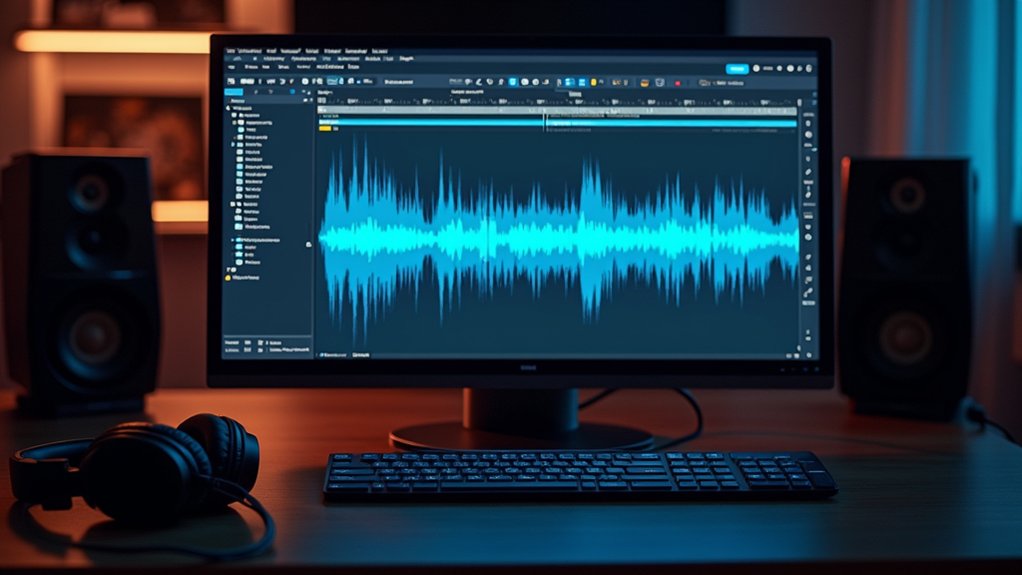To record voice-overs in Audacity, connect an external USB microphone or audio interface and select it as the input device. Set the output to headphones, configure recording to mono for vocal clarity, and use “Start Monitoring” to calibrate input levels. Record while visually monitoring waveforms to avoid clipping. Edit out mistakes, apply EQ and compression for enhancement, and export in WAV or MP3. The subsequent workflow elaborates on precise settings, ideal monitoring, and advanced post-production techniques.
Key Takeaways
- Connect a high-quality external USB microphone and select it as the input device in Audacity’s device toolbar.
- Set recording to mono, adjust input gain, and use “Start Monitoring” to ensure optimal input levels without clipping.
- Wear closed-back headphones and configure them as the output device to monitor your recording in real-time.
- Record your voice-over, then use the Selection Tool and waveform zooming to edit out mistakes or unwanted sections.
- Apply EQ and compression from the Effects menu, then export the finished audio as WAV or MP3 from the File menu.
Choosing and Connecting Your Microphone
Microphone selection and integration constitute critical steps in establishing a high-fidelity voice-over workflow in Audacity. The process begins with choosing a dedicated external USB microphone or an audio interface, both of which surpass built-in microphones regarding audio quality.
Once the microphone is physically connected, Audacity’s interface must be utilized to confirm device recognition. This is achieved by observing real-time activity in the input meters. Activating the “Start Monitoring” function enables the user to test and calibrate input levels precisely, using the gain control on the microphone or audio interface to prevent distortion or noise artifacts.
For ideal monitoring, appropriate headphone output selection is essential, providing immediate feedback and ensuring that the recorded signal maintains consistent, professional-grade audio quality throughout the session.
Selecting the Correct Input and Output Devices
Prior to commencing a recording session in Audacity, meticulous selection of both input and output devices is essential to guarantee signal integrity and monitoring accuracy.
When getting started, users should select a high-quality external microphone from Audacity’s input device drop-down menu, as built-in microphones typically yield subpar results. For monitoring, the output device should be set to headphones to prevent latency and guarantee precise audio playback.
The “Start Monitoring” feature in Audacity facilitates real-time input level assessment, enabling ideal gain staging. Although audio interfaces may present more than two channels, for voice-over work, recording should be set to one channel (mono), avoiding unnecessary complexity associated with left and right channel separation.
To record two USB mics simultaneously on different operating systems, users need to configure an Aggregate Device on Mac or use third-party software like VoiceMeeter on Windows. Attention to these parameters guarantees a controlled and professional recording environment.
Configuring Audacity for Voice-Over Recording
Once ideal input and output devices have been specified, the next phase involves configuring Audacity’s software parameters for streamlined voice-over recording.
Within Audacity, users should first select their chosen microphone—preferably a condenser or dynamic type—via the input drop-down, ensuring maximum compatibility with selected audio interface options.
For single-voice applications, setting the recording channel to mono is essential. Configuring the headphone output allows for precise monitoring of the recording environment in real-time, facilitating immediate detection of background noise or artifacts.
Utilizing Audacity’s “Start Monitoring” function, users can observe input levels and make real-time adjustments. Fine-tuning digital gain on the audio interface or USB microphone is critical to achieving robust signal levels without clipping, consequently maintaining professional-grade sound integrity throughout the recording process. Users should also adjust the sample rate and channels in the Quality section to ensure enhanced recording quality.
Setting Recording Channels for Optimal Clarity
For achieving maximum vocal clarity in Audacity, configuring the recording channel to mono is paramount. This setting guarantees that only a single audio track captures the voice source without unnecessary spatial duplication.
Mono recording techniques are essential for voice-overs, as they provide direct focus on vocal articulation and minimize phase issues inherent in stereo setups. Selecting “1 (Mono) Recording Channel” within Audacity’s preferences guarantees accurate representation of voice modulation, preserving the natural tonal qualities.
This approach prevents dilution of audio clarity and allows detailed post-processing on a consolidated track. Utilizing a high-quality external microphone further optimizes signal fidelity, capturing nuanced voice characteristics.
This process-oriented configuration underpins professional-grade audio clarity, forming the technical foundation for refined voice-over production workflows in Audacity. Additionally, setting the project sample rate to 44.1kHz ensures optimal sound fidelity, balancing quality and file size.
Monitoring Audio Levels Before Recording
How does one guarantee ideal voice capture fidelity before initiating a recording session in Audacity? Effective monitoring techniques are critical.
First, the correct microphone must be selected from Audacity’s input drop-down menu to guarantee peak sound clarity. Enabling the “Start Monitoring” feature allows real-time visualization of input levels on the meter, facilitating precise level adjustments. Observing these indicators helps prevent audio clipping, which manifests as meter peaks in the red zone and degrades recording quality.
Users should also configure recording channels to one, isolating the vocal signal and minimizing extraneous noise. Prior to recording, adjustments to the digital gain on the microphone or audio interface must be performed, guaranteeing balanced signal amplitude.
This preparatory workflow secures professional-grade audio fidelity for subsequent voice-over capture.
Capturing Your Voice-Over Performance
Capturing a high-quality voice-over in Audacity begins with selecting the best microphone from the input source menu and configuring the recording channel for monaural audio.
Employing the “Start Monitoring” function allows the user to calibrate input gain and verify that signal levels remain within the ideal range.
Initiating the recording process while continuously observing the meter guarantees real-time management of audio integrity and prevents unwanted distortion.
Implementing real-time monitoring allows for immediate performance adjustments, ensuring that you can make necessary tweaks on the fly to maintain optimal sound quality.
Microphone Selection and Setup
A critical determinant of voice-over recording fidelity lies in the selection and configuration of the microphone system. Selecting a high-quality external microphone—such as a condenser or dynamic model—over built-in computer microphones is essential for peak signal integrity.
The chosen microphone type should be connected via an appropriate audio interface or directly through a USB port, depending on its output specification. Within Audacity, users must designate the correct input source by accessing the drop-down menu, ensuring seamless hardware recognition.
For professional results in controlled recording environments, it is recommended to set the recording channel to mono, which best isolates the vocal signal. Adjusting the digital gain at the interface or microphone input mitigates risk of clipping, further enhancing the clarity and focus of the recorded voice-over.
Monitoring and Adjusting Levels
While preparing to record a voice-over in Audacity, rigorous monitoring and precise adjustment of input levels are paramount to capture a clean, distortion-free performance.
Users should first select the appropriate dedicated microphone from the input menu, avoiding built-in computer microphones to maximize audio fidelity. Activating Audacity’s “Start Monitoring” function enables real-time audio feedback techniques, facilitating accurate input level assessment.
The recording channel should be set to mono, enhancing clarity for voice-over applications. Employing closed-back headphones is essential for output monitoring, allowing immediate detection of unwanted noise and artifacts.
Throughout the session, dynamic adjustment of digital gain on the interface or USB microphone is required, ensuring levels remain within ideal range. Attention to recording environment enhancement and applying voice modulation tips further improve the resulting audio quality.
Quick Editing: Trimming and Removing Mistakes
Efficient removal of errors in Audacity begins by utilizing the Selection Tool to accurately highlight unwanted audio segments. The user can then execute immediate deletion by pressing the “Delete” key, ensuring rapid correction of mistakes. For ideal results, iterative playback and waveform zooming support precise verification of seamless audio continuity post-editing. Additionally, employing the zoom feature enhances accuracy during selection and trimming, allowing for a detailed view of the waveform to aid in identifying trim points.
Highlighting Unwanted Audio
Isolating unwanted audio in Audacity begins by clicking and dragging the cursor over the undesired section, visually designating the region for removal.
Employing audio visualization techniques, users interpret the displayed waveform to identify mistakes, silences, or extraneous noises. Through utilizing waveform analysis methods, one can pinpoint the precise start and end points of the problematic audio, ensuring only the necessary region is selected.
Efficient editing practices recommend utilizing the zoom tool for granular inspection, which enhances accuracy when highlighting brief sounds or subtle errors. This meticulous selection process is foundational for maintaining continuity in voice-over projects.
Should an error occur during selection, Audacity’s undo functionality (Ctrl+Z or Command+Z) allows immediate reversal, supporting a non-destructive workflow and facilitating iterative, professional audio editing.
Deleting Mistakes Efficiently
Streamlining the audio editing process in Audacity involves utilizing direct manipulation techniques to excise mistakes with minimal disruption to the project timeline.
Efficient editing techniques begin by highlighting sections containing common recording mistakes, then pressing the “Delete” key for immediate removal. For targeted audio refinement, users can employ the trimming tool by dragging the edges of highlighted regions to achieve precise cuts.
Enhanced accuracy is facilitated by the waveform zoom function (Ctrl+1 or Command+1), enabling granular selection and deletion. If errors occur during trimming or deletion, the “Undo” feature (Ctrl+Z or Command+Z) swiftly restores prior states.
As a final audio cleanup tip, playback should confirm seamless shifts and the absence of residual noise or silence, ensuring professional, polished results in voice-over projects.
Applying Effects to Enhance Your Audio
Finding your way to the “Effect” menu in Audacity grants access to an array of audio processing tools essential for voice-over enhancement, including compression, equalization (EQ), and reverb.
Applying dynamic equalization techniques allows targeted adjustment of frequency bands: boosting the midrange enhances vocal presence, while attenuating lows reduces muddiness. A compression settings guide recommends threshold and ratio parameters to even out dynamic range, ensuring consistent loudness and minimizing distortion risk.
Utilizing the Preview function enables real-time listening of your adjustments before permanent application, helping you assess the impact and make informed decisions without introducing artifacts.
Audio enhancement tips include previewing each effect before permanent application to assess impact in real time.
Key steps for effective processing:
- Apply EQ to clarify and balance vocal frequencies.
- Use compression to control dynamic range and maintain consistent volume.
- Preview and carefully review post-effect audio to avoid introducing artifacts.
Exporting Your Finished Voice-Over File
Initiate the export process in Audacity by maneuvering to the “File” menu and selecting “Export,” where format options such as WAV and MP3 are available to suit various delivery requirements. Selection of export formats directly impacts audio quality and compatibility; WAV provides uncompressed fidelity, whereas MP3 offers compression for smaller file sizes. If exporting to MP3, installation of the LAME MP3 encoder is required. Within the export dialog, access “Options” to specify bit rate and encoding parameters, optimizing audio quality per project specifications. Conduct final checks by reviewing the entire recording for artifacts or inconsistencies. Utilize the zoom feature for precise viewing of audio segments before export, ensuring that only the desired segments are retained after trimming. Post-export, verify the destination folder for file accessibility, ensuring the voice-over is readily available for distribution or archival.
| Step | Emotional Impact |
|---|---|
| Choose Format | Anticipation |
| Set Quality | Assurance |
| Final Checks | Confidence |
| Locate File | Satisfaction |
Frequently Asked Questions
How Do You Record Voice Overs in Audacity?
To record voice overs in Audacity, users prioritize microphone selection, configure audio interfaces, and optimize the recording environment. They set mono channels, monitor input levels, initiate recording, and apply post-processing effects, such as compression and EQ, for clarity.
What Are the Best Settings for Audacity Voice Over?
Ideal Audacity voice-over settings include high-quality external microphone selection, mono channel configuration, precise input gain adjustment, application of noise reduction effects, and exporting in lossless audio formats such as WAV for maximum fidelity and professional post-production flexibility.
How Do You Process a Voice Recording?
To process a voice recording, one applies audio effects such as compression and normalization, utilizes equalization techniques for tonal balance, and employs noise reduction algorithms to minimize unwanted background sound, ensuring clarity and professional-grade audio quality throughout the workflow.
What Is the Best Audio Setting for Voice Recording?
Ideal audio settings for voice recording require precise microphone selection, thorough acoustic treatment, and a controlled recording environment. Combined with mono channel configuration, 44.1 kHz sample rate, and input gain adjustment, these factors guarantee clarity, minimal noise, and professional results.
Conclusion
By meticulously selecting appropriate hardware, configuring Audacity’s input/output settings, optimizing channel parameters, and monitoring pre-recording levels, users ascertain high-fidelity voice capture. The workflow emphasizes precise editing—trimming extraneous content and correcting errors—followed by targeted effects application to enhance sonic characteristics. Effective export procedures assure deliverable-ready audio files. Adhering to these process-driven steps, practitioners can reliably produce professional-grade voice-overs, utilizing Audacity’s robust feature set for consistent, broadcast-quality results in diverse production environments.




